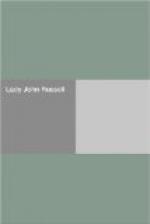This Bill, after being carried in the House of Commons, was rejected by the House of Lords, and it was not till June, 1832. that the great Reform Bill (the third introduced within twelve months) became the law of the land. Lord John, who had been admitted to the Cabinet in 1831 during Lord Grey’s Government, became Home Secretary in Lord Melbourne’s Government in 1835, and in 1839 he was appointed Colonial Secretary, which office he held at the time of his second marriage. Up to this point we have only followed his career at a distance, but now through the letters and diaries of his wife we shall be enabled to follow it more intimately to the end.
CHAPTER IV
1841-45
Lord and Lady John Russell stayed at Bowhill till the 31st of July. They had a grand reception at Selkirk on their way back to Minto—a procession headed by all the magistrates, a band of music, and banners flying. Lord John was given the freedom of the burgh, and was received with enthusiasm by the inhabitants. After a short visit to Minto they went to London, to his house in Wilton Crescent.
BOWHILL, July 29, 1841
I hardly know how to begin my journal again. I wrote the last page as Fanny Elliot; I am now Fanny Russell.... Forgive me, Almighty Father, for the manifold sins, errors, and omissions of my past life, [a life] to which I look back with deep gratitude for its countless blessings, especially for the affection of those with whom I spent it, so far beyond what I deserved. Enable me to think calmly of the Mother whom I have left.... I was, and still am, in a dream; but one from which I hope never to wake, which I trust will only grow sweeter as the bitter days of parting wear away, as I become more and more the companion and friend of him whose heart is mine as truly as mine is his, and in whom I see all the strength and goodness that my weak and erring nature so much requires.
This is a perfect place and the days have flown—each walk lovelier than the last. Much as poets have sung Ettrick and Yarrow, they have not, and cannot, sing enough to satisfy me.... I am so sorry that to-morrow is our last day, though it is to Minto that we go, but I feel as if a spell would be broken—a spell of such enchantment.
Lady John Russell to Lady Mary Abercromby




